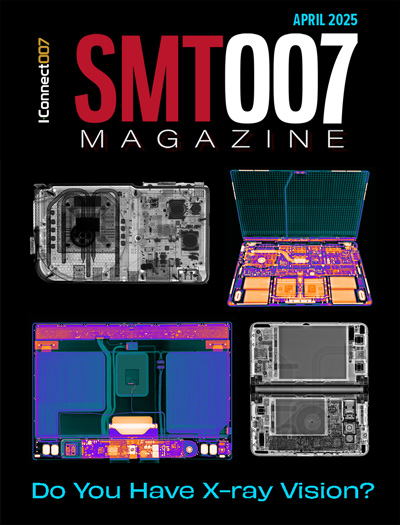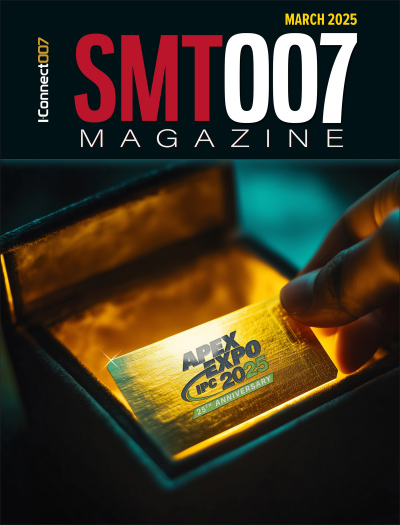-

- News
- Books
Featured Books
- smt007 Magazine
Latest Issues
Current Issue
Do You Have X-ray Vision?
Has X-ray’s time finally come in electronics manufacturing? Join us in this issue of SMT007 Magazine, where we answer this question and others to bring more efficiency to your bottom line.

IPC APEX EXPO 2025: A Preview
It’s that time again. If you’re going to Anaheim for IPC APEX EXPO 2025, we’ll see you there. In the meantime, consider this issue of SMT007 Magazine to be your golden ticket to planning the show.

Technical Resources
Key industry organizations–all with knowledge sharing as a part of their mission–share their technical repositories in this issue of SMT007 Magazine. Where can you find information critical to your work? Odds are, right here.
- Articles
- Columns
Search Console
- Links
- Media kit
||| MENU - smt007 Magazine
Beyond AOI - SMT Quality Control
December 31, 1969 |Estimated reading time: 6 minutes
The automatic inspection machine in SMT came about in the early 1990s. Now there is a range of processes that AOI can accomplish in this field. AOI is imperative on the line. If the development and implementation of AOI is done correctly, this technology will change the quality scenario in the SMT field.
By Parminder Singh
The need for AOI is imperative to quality assurance throughout the SMT line. One contract manufacturer of computer motherboards made 350 boards a day, reaching first pass yields of 98%. A re-inspection was planned for all of the 98% boards that passed. A quality assurance inspector (QAI) re-inspected the boards, followed by a re-inspection by four more QAIs: QAI-1, QAI-2, QAI-3 and QAI-4. The inspection process featured one operator, a 30× microscope and a 5× tape-top magnification lens. The experiment entailed the following:
Number of SMT components: ~240Fine-pitch components 20 mil: 1 “No”Fine-pitch components 25 mil: 2 “No’s”PLCC package 84-pin: 1 “No”
For the experiment, it is evident that a human may skip a few defects during inspection; and the condition can worsen when critical defects go unnoticed. Placing multiple QAIs on the line will increase the cost of quality control (Figure 1). There are many factors that can affect the quality of an inspection performed by humans, worker efficiency changes throughout the day, which is natural and inevitable. Only machines can perform the repeated and consistent inspection according to defined machine capabilities. The need for an AOI machine that can inspect these defects was required for components after reflow.
 Figure 1. Rejection analysis of motherboard inspections.
Figure 1. Rejection analysis of motherboard inspections.
When AOI first entered the market, it was based on pattern-matching technology, which inspects the boards with respect to known good board - an apple-to-apple comparison. The major drawback was that it compares 1:1. If there is a slight shift in the component or change in the component color, it rejects the component. The component library must be updated in case it rejects a good component. Consequently, the library database for one component increases. Therefore, one component machine must compare all the images stored for that component in the library. This reduces the throughput of the machine. The machine must be able to inspect the defect intelligently. This brings into light the capabilities of AOI. There are four stages for AOI:
- Inspection after printing.
- Pre-reflow inspection.
- Post-reflow inspection.
- Combination of pre- and post-reflow analysis.
Inspection After Printing
Most printers currently have 2.5-D inspection systems to yield good results effectively. A machine that results in six to seven defects per million opportunities (DPMO) should be sufficient. Therefore, the need for a separate inspection machine is ruled out. If volumes are high, then throughput from the printer will be the main concern. Buying an AOI machine should not be ruled out.
Pre-reflow Inspection
Pattern matching. This is a useful feature for BGA and CSP inspection. Although it is not possible to inspect the solder joints, users can at least check component alignment with respect to component pads. The maximum allowed misalignment can be defined per the process window. Modification in the AOI software is required; this feature also can be used for non-standard components that are not in the AOI standard-component library.
Placement defect analysis. Misalignment, missing components and upside-down components are some of the critical defects that affect the quality of a pick-and-place machine. Current AOI systems are inspecting these components; however, intelligent software is required to correctly analyze defects. This may require a small modification in software. Defect analyses should be done according to workmanship or customized standards. For example, if the component body is 10% out of the pad, then the component would pass inspection. If there are two pad designs for the same package, then the criteria for misalignment should not be the displacement of the component from the center of the pad (Figure 2). A detailed mathematical calculation should be done for different pad sizes with respect to component packaging during the programming and setup of an AOI machine.
 Figure 2. If there are two pad designs for the same package, the misalignment criteria should not be the displacement of the component from the center of the pad. In this example, Component A will pass and Component B will fail.
Figure 2. If there are two pad designs for the same package, the misalignment criteria should not be the displacement of the component from the center of the pad. In this example, Component A will pass and Component B will fail.
Closed-loop feedback system to the machine. This is an interesting feature to implement in an AOI machine. If there is a consistent shift observed in a few components during production, the machine should offer immediate feedback to pick-and-place machines and generate an audio/visual alarm. This feedback should be in the form of a file specifying the amount that components have shifted. Changes will be made in the existing component placement data according to the feedback file. If the component placement software of a pick-and-place machine is integrated with AOI software, users have the option to make direct changes in the XY data of the pick-and-place machine, saving the original file and decreasing downtime.
Machine Capability Analysis
If implemented, capability analysis will become an important tool to monitor machine capabilities. Cp and Cpk of the machine can be calculated easily with an AOI machine. Machine accuracy and repeatability can be checked using tools such as a closed-loop feedback system, which also can help in quantifying the pick-and-place machine performance with time. The Cp and Cpk of an AOI machine was also calculated. The number of false calls in the machine is important to determine an AOI machine’s capabilities.
Post-reflow Inspection
Process capability analysis. We can calculate or monitor process capability on a regular basis. This will be a real-time process control.
Reflow-defect analysis. By using Pareto analyses, fish-bone diagrams and control charts, we can take corrective action regularly in a real-time environment.
Combination of pre- and post-reflow analysis. This is an important tool to design optimum pads for PCBs. Due to solder paste that pulls toward the center of the pad, chip components placed at an offset from the center of the pads are aligned automatically toward the center after reflow. There is a defined limit for the offset component to be aligned in reflow, beyond the component that will not be able to center in reflow (Figure 3). If we can calculate this limit, we can feed the same limits into the AOI machine, which is placed after pick-and-place.
 Figure 3. Due to solder paste that pulls toward the center of the pad, chip components placed at an offset from the center are aligned automatically toward the center after reflow.
Figure 3. Due to solder paste that pulls toward the center of the pad, chip components placed at an offset from the center are aligned automatically toward the center after reflow.
Modular camera unit or multi-camera unit. As component packages shrink, high-resolution cameras are required for inspection. For smaller components, there is less field of view (FOV), reducing overall throughput and requiring the use of multiple cameras.
Statistical Process Control
Traceability. AOI will help keep track of the defect history for a particular PCB. Complete traceability of the PCB is maintained. Handheld cameras for sample inspection. This allows QAIs to do an online inspection on a sample basis.
Conclusion
This is the beginning of AOI’s capabilities. Strong software and hardware development is needed to implement innovative ideas. AOI is imperative on the SMT line. If studied in detail, AOI machines can be used for other purposes, such as bare PCB inspection and thru-hole component inspection. If these developments and implementations are accomplished correctly, AOI will change the industry’s quality scenario. Achieving six sigma no longer will be a dream.
Parminder Singh, SMT manager, Elymer International Private Limited, may be contacted via e-mail: parmindersinghjass@gmail.com.


